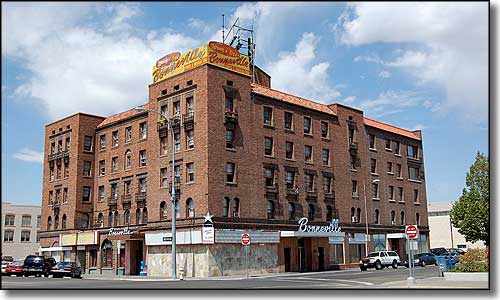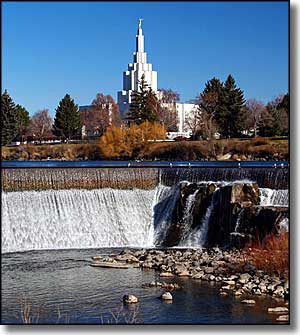 |
Idaho Falls, Idaho |
 The Bonneville Hotel in Idaho Falls, Idaho |

Idaho Falls is only the most recent name of the settlement that grew up near Taylor's Crossing, a timber frame bridge built across the narrow black basaltic gorge of the Snake River. The bridge was built by Matt Taylor in 1865 for the purpose of relieving incoming settlers, freighters and miners of a few bucks and allow them an easier crossing of the Snake in their journeys westward. By 1866, the settlement was known as Eagle Rock (the name of a former ferry crossing of the Snake that had been several miles further north). In the late 1870's, the Utah & Northern Railroad was bought by the Union Pacific Railroad and began laying tracks to the big copper mines in Butte, Montana, going right through Eagle Rock. By early 1879, Eagle Rock was a typical wild camp-town with the usual assortment of saloons, gambling dens and dance halls. In April and May, 1879, the railroad imported an 800' bridge in 2 spans to cross the river next to Taylor's bridge. As soon as the railroad came through, in came the settlers, looking to set up shop and farm and ranch in the Upper Snake River Valley. Most of these new settlers were Mormon and they built roads, dams, irrigation canals and bridges. In 1891, Eagle Rock voted to rename itself Idaho Falls, after the rapids in the Snake River below the railroad bridge. In 1895, water was diverted from the Snake River into the Great Feeder, the largest irrigation canal in the world at that time. It turned tens of thousands of acres of desert into green farmlands raising potatoes, sugar beets, peas, alfalfa and grains. Idaho Falls was primarily an agricultural center until the Atomic Energy Commission opened the Idaho National Laboratory and began extensive research into the possibilities of nuclear power in 1949. After several hushed up failures, they finally succeeded in building a design for a nuclear electric generating plant that worked. The Laboratory started cutting back in 1993 and Idaho Falls was forced to diversify to survive. Inc. Magazine rated Idaho Falls #8 on its 2006 list of "Hottest Small Cities in the US" based on the previous 10 years' job growth rate. Based on quality of life, cost of living and job prospects, MSN Real Estate rated Idaho Falls as #2 on their top ten list of best smaller cities in America that same year. |
| Fast Facts about Idaho Falls, Idaho |
|
Idaho Falls, Bonneville County, ID
Zip Codes: 83401-83406, 83415 Incorporated: 1891 Elevation: 4,705' Latitude: 43.4918°N Longitude: 112.0325°W Resident Racial Breakdown: White Non-Hispanic: 85.9% Hispanic: 10.7% Asian: 1.2% African-American: 0.4% Native American: 0.8% Other: 0.1% Two or More Races: 1.0% Education: High School or Higher: 87.7% Bachelor's Degree or Higher: 28.2% Graduate or Professional Degree: 9.8%
2009 Estimates: Population: 55,312 Males: 27,361 Females: 27,951 Median Resident Age: 32.3 Years Estimated Median Household Income: $42,700 Estimated Median Home Value: $149,100 Population Density: 3,241 People per Square Mile 2011 Cost of Living Index for Idaho Falls: 88.3 Major Industries: Professional Services, Educational Services, Lodging & Food Services, Construction, Government, Health Care, Finance & Insurance Services, Retail Services Unemployed (March 2011): 8.6% |
|
|
 |
| Index - Arizona - Colorado - Idaho - Montana - Nevada - New Mexico - Utah - Wyoming National Forests - National Parks - Scenic Byways - Ski & Snowboard Areas - BLM Sites Wilderness Areas - National Wildlife Refuges - National Trails - Rural Life Advertise With Us - About This Site - Privacy Policy |
| Photo of the Bonneville Hotel in Idaho Falls, Idaho courtesy of Wtrtwnguy, CCA ShareAlike 3.0 License. Photo of Idaho Falls LDS Temple courtesy of Twunchy, CCA ShareAlike 3.0 License. Text Copyright © by Sangres.com. All rights reserved. |